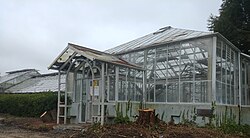Washington State Capitol Conservatory
 From Wikipedia - Reading time: 4 min
From Wikipedia - Reading time: 4 min
| Washington State Capitol Conservatory | |
|---|---|
 Conservatory in semi-abandoned state, 2019 | |
 | |
| Former names | Washington State Capitol Greenhouse |
| General information | |
| Type | Greenhouse |
| Location | Washington State Capitol campus |
| Address | 1115 Water Street |
| Town or city | Olympia, Washington |
| Country | United States |
| Coordinates | 47°02′16″N 122°54′13″W / 47.0377°N 122.9037°W |
| Construction started | 1938 |
| Opened | 1939 |
| Renovated | 1976 |
| Closed | 2008 |
| Cost | $25,000 |
| Owner | State of Washington Department of Enterprise Services |
| Technical details | |
| Floor count | 2 |
| Floor area | 11,300 sq ft (1,050 m2) incl. basement shops |
| Design and construction | |
| Architect(s) | Joseph Wohleb |
| References | |
| Some building structural data from State of Washington DES[1] | |
The Washington State Capitol Conservatory was a greenhouse on the grounds of the Washington State Capitol in Olympia, Washington. It was funded $25,000 in 1938, designed by architect Joseph Wohleb, and built in 1939 as a Works Project Administration project.[2] In the 1990s it was noted the greenhouse was suffering foundation damage from soil settling of up to 65-foot (20 m) deep fill on which it was built.[3] A 1995 report indicated that there was fear of a landslide causing catastrophe to the building, built next to a steep ravine where "a number of springs and wet areas were observed" (Olympia is noted for both its rainy climate and its artesian springs).[3] Heritage Park's hillside trail climbs from Capitol Lake to a landing containing the Law Enforcement Memorial, adjacent to the conservatory.[4] Due to safety concerns stemming from the settling, the conservatory was closed in 2008[5] and the building was demolished between 2020 and 2021.[6] For a time it was used to store the Chief Shelton Story Pole (totem pole) after it was taken down in 2010.[7] Until its closure it was open to the public and was an attraction for visitors to the State Capitol.[8][9]
Capitol gardens
[edit]The gardens and grounds at the Capitol campus were filled with plants grown in the conservatory. Over 70,000 flowers and plants each year were grown there in the 1950s.[2]
-
Sunken garden outside the conservatory (looking south towards Insurance Building and State Capitol)
References
[edit]- ^ Capitol Conservatory building factsheet (PDF), State of Washington Department of Enterprise Services
- ^ a b Jennifer Crooks (October 22, 2017), "Changing Seasons: A History of the State Capitol Campus Conservatory", Thurston Talk
- ^ a b Stephen P. Palmer; Wendy J. Gerstel (January 19, 1995), Capitol Campus Greenhouse Soil Stability Investigation Status Report (PDF), Washington Department of Natural Resources Geology and Earth Resources Division
- ^ Capitol campus map (PDF), Washington State Legislature
- ^ HISTORIC CAPITOL CAMPUS CONSERVATORY CLOSES SEPT. 5 (press release), Washington State Department of General Administration, September 3, 2008, archived from the original on February 23, 2018 – via HighBeam
- ^ "Capitol Conservatory". Department of Enterprise Services. 2020-08-24. Retrieved 2021-06-16.
- ^ Lynda V. Mapes (April 27, 2011), "The next chapter for old story pole yet to be written.", The Seattle Times, archived from the original on February 23, 2018 – via HighBeam
- ^ Leson & Irving 1996, p. 354.
- ^ Don Jenkins (January 9, 2005), "Capitol dome reopens; campus open to public", The Columbian, Vancouver, Washington, archived from the original on February 23, 2018 – via HighBeam
Sources
[edit]- Leson, Nancy; Irving, Stephanie (1996). Seattle Best Places: The Most Discriminating Guide to Seattle's Restaurants, Shops, Hotels, Nightlife, Arts, Sights, and Outings. Best Places Guidebooks. Sasquatch Books. ISBN 978-1-57061-055-4. Retrieved 2018-02-22.
External links
[edit] Media related to Washington State Capitol Conservatory at Wikimedia Commons
Media related to Washington State Capitol Conservatory at Wikimedia Commons
 KSF
KSF